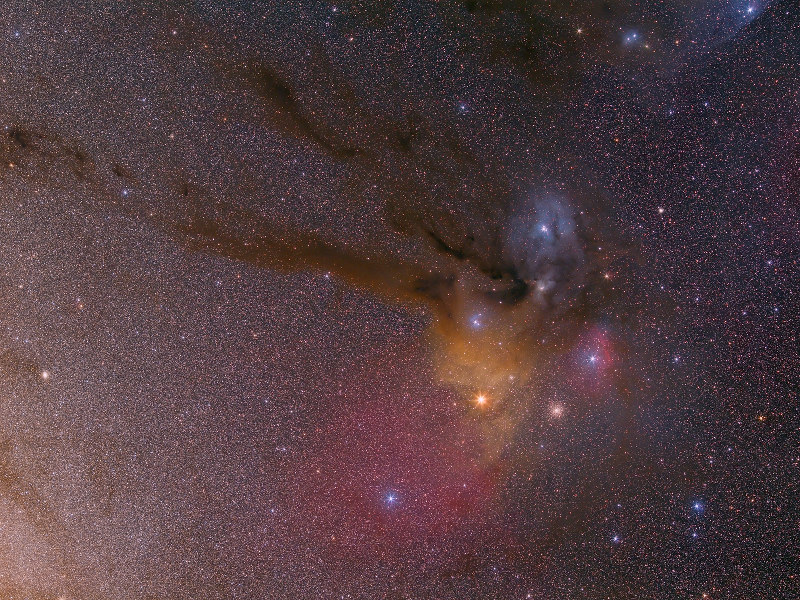It's great to see a superb RGB nebula image as an APOD!

They are so rare these days.
APOD Robot wrote:
The red and yellow regions shine primarily because of emission from the nebula's atomic and molecular gas.
That's not true. Well, it's certainly true that the red regions shine because of emission, but the same thing can't be said about the large yellow patch in the picture. This patch is simply a yellow reflection nebula, reflecting the yellow-orange (not red) light of Antares. Yellow reflection nebulas are rare, but Antares is bright and the vicinity is very dusty.
The large blue reflection nebula is produced by the small, tight group of B-type stars, of which Rho Ophiuchi itself, a B2V-type star, is the brightest. These stars are not hot enough to produce an emission nebula, but they are bright and blue, and so much of their blue light has been scattered all over that huge nebula that the stars themselves reportedly don't look blue-white through a telescope, but yellow-white. I don't know if that is true. By contrast, the bright stars of the Pleiades certainly look blue-white through a telescope even though they have spread out quite a bit of their blue light in their dusty surroundings, thereby producing that
famous Pleiades nebula. (And by the way... why does the Sun look yellowish? It is at least partly because an appreciable amount of the shortwave sunlight that reaches the Earth has been scattered in the Earth's atmosphere.)
The red Hα emission in the Rho Ophiuchi region is interesting. There is not that much of it. The brightest Hα light is produced by Sigma Scorpii, an interesting
spectroscopic binary whose components seem to be a bit of a mystery. According to Wikipedia, both components belong to spectral class B1 (Houk, Nancy (1978), Michigan catalogue of two-dimensional spectral types for the HD stars 4, Ann Arbor: Dept. of Astronomy, University of Michigan, and North, J. R.; et al. (September 2007), "Orbital solution and fundamental parameters of σ Scorpii", Monthly Notices of the Royal Astronomical Society 380 (3): 1276–1284, arXiv:0707.0897). But
Jim Kaler describes them as spectral classes B2 and O9, and
Simbad Astronomical Database calls them O9.5V and B7V.
In any case, it is clear that (at least one of) the components of Sigma Scorpii are right at the dividing line between spectral classes O and B. They are hot enough to ionize a nebula, but not a very bright or large one. The brightest, reddest of the emission nebula is a "wall" that has been built up as the wind from the stars drive gas and dust into a relatively dense dust cloud on one side of the binary, and the collision itself produces Hα emission. The stars also emit quite a lot of blue light, which is scattered as a blue reflection nebula.
Rho Ophiuchi region. Photo: Marcin Paciorek.
There is one more red emission nebula in the picture, but its source can't be found in today's APOD. To find its source, check out the image at left by Marcin Paciorek. In Paciorek's image you can see a large, faint emission nebula to the lower left of Antares, and inside this nebula sits the blue star Tau Scorpii, whose spectral class (according to
Simbad Astronomical database) is B0.2V. Don't you love the precision of the spectral classification?
Personally I love seeing Tau Scorpii in Rho Ophiuchi images, because I consider this star and its nebula a part of the entire nebula complex. But I sure love today's Tau Scorpii-less APOD, too!
Ann
 The Colorful Clouds of Rho Ophiuchi
The Colorful Clouds of Rho Ophiuchi